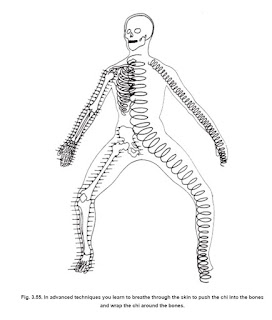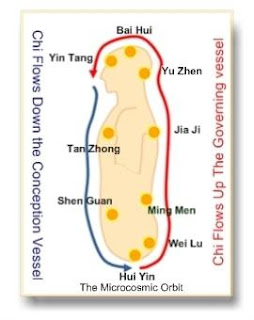Algorithm for learning the Basics of Internal Strength: A Universal Approach A lot of people want some simple directions for getting their foot in the door for "internal strength", qigongs, and various martial-arts, so this article is an attempt to suggest basic goals and skills that will apply across many different Asian martial arts and qigongs. It's nice to have a lot of academic discussions about the intricacies of "internal" practice, in our forum discussions, but without significant results it's all just a lot of talk and role-playing. What are the keystone elements we should be examining and practicing? Once we know and understand the key elements, what training actions can we apply across the board in Chinese martial arts, qigongs, and related studies? First of all, remember that the Chinese martial arts and qigongs can be looked at as methods of developing the "internal strength" that has to do with the involuntary-musc
Posts
Showing posts from December, 2020
- Get link
- Other Apps
SEQUENCE OF JIN SKILLS I thought I would post my opinion about a sequence of jin skills, as they are developed, but it would be nice if other people would contribute their own opinions, critiques, and so on. Thanks. "Jin" refers to a force direction, usually sourced from either the ground's solidity at the sole of the foot or the downward pull/force of gravity on our body. Jin is the result of our body's inherent ability to make corrective forces by using involuntary-muscle/fascia systems to create directed stressors in our bodies. In other words, it is the "qi-tissues" or "qi" that forms the jin forces. That's why the common definition of "jin" is that it is "the physical manifestation of the qi". A good basic idea of the body's natural "jin" ability can be had by imagining that we are in a swimming pool in chest-deep water. Remember foremostly that instead of using the torso for forces, we should sou
- Get link
- Other Apps
USING HERBS TO STRENGTHEN THE QI Harking back to the "Python" thread earlier today and thinking of the qi/"suit" as being more or less a superficial group of involuntary-muscle/fascia/subconscious systems, we can see why the Chinese thought about and developed herbal remedies to strengthen and develop the qi. From what I'm aware of, special herbs dips or satchets of herbs tied next to the skin are not uncommon conditioning methods to "strengthen the qi". In the video below, the famous Ho Xu Yin was shown in a film brewing an herbal concoction that he boys soaked in as part of their conditioning. How effective is such a thing? I have no idea, but apparently a number of martial-arts styles use such a supplement to training, so they must as least think there is some practical effectiveness to it. https://vimeo.com/492954675 Here's a video from a documentary about Chuo Jiao, a very ancient fighting system in China. They specialize in extremely
- Get link
- Other Apps

CROSSOVER/X OR SAME SIDE "HARMONY"/COORDINATION? There's a discussion about the coordination of the "Three External Harmonies" (wrist/ankle, elbow/knee, shoulder/hip) and whether that coordination is along one side or whether it is meant as, for instance, right-arm to left-leg. Maybe it's a good discussion topic, so I'll toss out my thoughts and I'll listen carefully to others' opinions because it's not something that I've ever thought of as other than an interesting thought-starter. The muscle-tendon (or "Sinew") channels, of which the "acupuncture meridians" are just overlays, are the basic channels or routes along which our strength 'flows' as we move between Open and Close. So, generally speaking, the strengths/forces that we use to stand up, push, and Open the body go up the channels of the back, the strengths/forces that we use to curl/contract/Close the body generally come down the front of the body (e
- Get link
- Other Apps

PYTHON, SUIT, & DANTIAN The snake is considered to be the animal that is representative of Qi, so let's think about how a snake feels. When I was young and stupidly macho I used to go hunting in the swamps with my mates and we'd catch poisonous snakes (and non-poisonous ones, too) so we could sell them to a nearby serpentarium. So, I know what a snake coiled and constricting around the arm feels like; some of you may have to imagine it: it's a powerful, squeezing sensation. A snake can be thought of as a dense cylinder of muscles built around a hollow cavity that has the lungs and organs in it and that's what we have to imagine for our qi-body: it's the outer covering of our body that is composed of a lot of involuntary muscle systems that we have to learn to squeeze and manipulate the body with. So let's imagine that our torso, arms, legs, hips, neck, etc., are covered with a thin layer of muscles and it is that layer that I usually refer to as the "
- Get link
- Other Apps

REVERSE BREATHING AND THE MICROCOSMIC ORBIT When you do a reverse-breath, you inhale while slightly pulling in the abdomen and simultaneously pulling up the perineum/anus area. If you do these things correctly, you'll feel a sort of pressure area at the anus/perineum (AP) area that you can sort of pull up the spine to the lower back (Mingmen) area. Upon exhale, you let the pressure area drop forward and downward. This cycle of movement is the basic power-storage movement that is common throughout the Chinese martial-arts. I'm also pretty sure that the mechanism was well-known in the Japanese martial-arts, based on a comment I read in an old novel about ki and power development. Try the above inhale pulling in and upward, then the drop-release exhale a few times. You should be able to feel the general mechanism pretty easily. What makes this mechanism difficult for westerners to grasp has usually been the vague and obscure directions in so many of the old texts and di
- Get link
- Other Apps

Reverse Breathing Overview Matt Chandler Smith asked a question about reverse breathing, so I'll make another run at it. The problem I run into is that reverse-breathing as a supplement to the body's strength is a fairly complex topic, yet it's always desirable to convey an idea using simple terms and simple models. No description is going to be perfect. I use the idea of an elastic "suit" and the body inflating/pressurizing to "store" energy, and then deflating/contracting as it expends/releases energy. The "energy" being discussed is stored (potential energy) and released mechanical energy (kinetic energy), not to be confused with the somewhat loose usage of the term "energy" in New Age discussions. The general picture to bear in mind is that the human body is a muscle-bone-tendon mechanism, as we usually think of it, but it is covered with a sort of elastic "suit", if you will, that supplements o